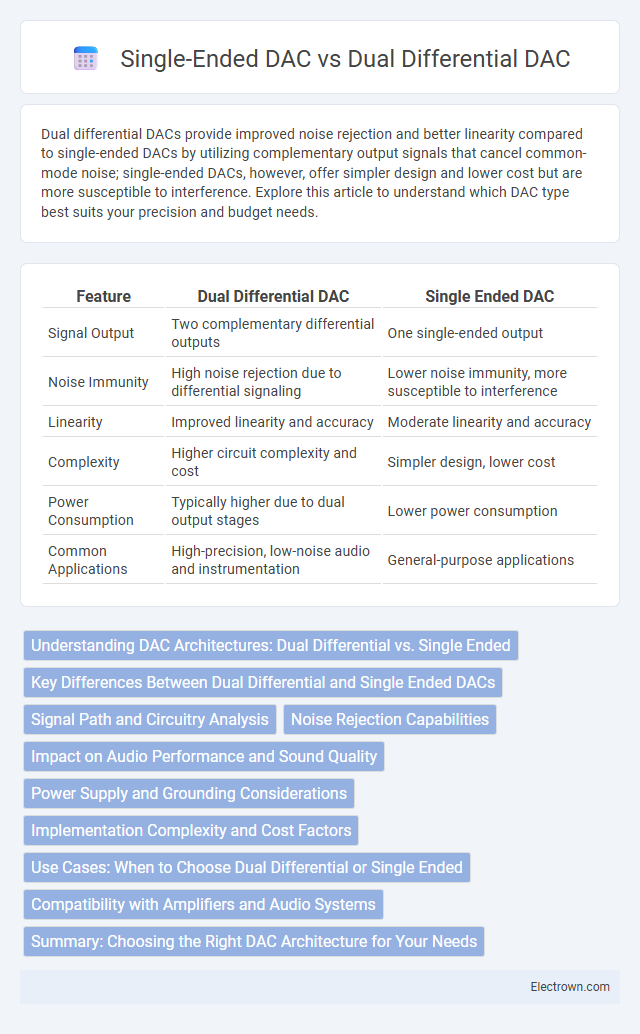Dual differential DACs provide improved noise rejection and better linearity compared to single-ended DACs by utilizing complementary output signals that cancel common-mode noise; single-ended DACs, however, offer simpler design and lower cost but are more susceptible to interference. Explore this article to understand which DAC type best suits your precision and budget needs.
Table of Comparison
| Feature | Dual Differential DAC | Single Ended DAC |
|---|---|---|
| Signal Output | Two complementary differential outputs | One single-ended output |
| Noise Immunity | High noise rejection due to differential signaling | Lower noise immunity, more susceptible to interference |
| Linearity | Improved linearity and accuracy | Moderate linearity and accuracy |
| Complexity | Higher circuit complexity and cost | Simpler design, lower cost |
| Power Consumption | Typically higher due to dual output stages | Lower power consumption |
| Common Applications | High-precision, low-noise audio and instrumentation | General-purpose applications |
Understanding DAC Architectures: Dual Differential vs. Single Ended
Dual differential DACs utilize two complementary output signals, enhancing noise rejection and linearity compared to single-ended DACs, which produce a single output referenced to ground. The differential architecture improves signal integrity by minimizing common-mode noise and distortion, making dual differential DACs ideal for high-precision and high-frequency applications. Single-ended DACs offer simpler design and lower cost but may suffer from increased susceptibility to noise and reduced dynamic range.
Key Differences Between Dual Differential and Single Ended DACs
Dual differential DACs feature two complementary outputs that improve noise immunity and signal integrity, offering better linearity and reduced distortion compared to single-ended DACs, which provide a single output referenced to ground. The differential design enhances dynamic range and common-mode noise rejection, making it ideal for high-precision applications, whereas single-ended DACs are simpler and more cost-effective for less demanding environments. Your choice depends on the application's noise sensitivity, required accuracy, and budget constraints.
Signal Path and Circuitry Analysis
Dual differential DACs feature two complementary outputs providing balanced signals that enhance noise immunity and reduce distortion in the signal path. Single-ended DACs utilize a single output reference, making their circuitry simpler but more susceptible to common-mode noise and interference. Analyzing the circuitry, dual differential designs require matched pairs of current sources or voltage references for precise differential signaling, while single-ended DACs rely on single-ended topologies that may introduce more harmonic distortion due to asymmetric loading.
Noise Rejection Capabilities
A dual differential DAC offers superior noise rejection capabilities compared to a single-ended DAC due to its balanced signal processing that cancels out common-mode noise. This design effectively minimizes interference from electromagnetic sources and power supply fluctuations, resulting in cleaner output signals. If your application demands high precision and low distortion, choosing a differential architecture can significantly enhance signal integrity.
Impact on Audio Performance and Sound Quality
Dual differential DACs offer superior audio performance by significantly reducing even-order harmonic distortion and minimizing common-mode noise, resulting in clearer and more accurate sound reproduction. Single-ended DACs, while simpler, are more prone to noise interference and distortion, which can degrade sound quality in high-fidelity systems. The balanced nature of dual differential designs enhances dynamic range and channel separation, delivering a more immersive and detailed listening experience.
Power Supply and Grounding Considerations
Dual differential DACs require precise power supply regulation and careful grounding techniques to minimize noise and distortion by ensuring balanced voltage rails and symmetrical ground references. Single-ended DACs typically demand less complex power supply schemes but are more susceptible to ground loop noise and voltage fluctuations, impacting signal integrity. Proper layout with dedicated analog and digital grounds and low-noise linear regulators is critical to optimize performance in both DAC architectures.
Implementation Complexity and Cost Factors
Dual differential DACs require more complex circuitry involving paired converters and additional components, increasing implementation complexity compared to single-ended DACs. The cost factors escalate due to the need for matched differential pairs, extra amplifiers, and precise layout considerations to minimize noise and distortion. Your choice should weigh the benefits of improved noise immunity and signal integrity against the higher design complexity and manufacturing expenses.
Use Cases: When to Choose Dual Differential or Single Ended
Dual differential DACs excel in high-precision audio and instrumentation applications where superior noise rejection and linearity are critical, making them ideal for professional audio equipment and sensitive measurement systems. Single-ended DACs are suitable for cost-sensitive and simpler designs such as consumer electronics and basic signal generation, providing adequate performance with lower complexity. You should choose dual differential DACs when your application demands enhanced signal integrity and minimal distortion, while single-ended DACs suffice for everyday, less demanding tasks.
Compatibility with Amplifiers and Audio Systems
Dual differential DACs provide superior compatibility with balanced amplifier inputs and professional audio systems, reducing noise and crosstalk for improved sound quality. Single-ended DACs pair well with unbalanced amplifiers and consumer audio equipment, ensuring straightforward integration and cost-effectiveness. Matching your DAC type to your amplifier's input design optimizes signal integrity and overall audio performance.
Summary: Choosing the Right DAC Architecture for Your Needs
Dual differential DACs provide improved noise rejection and higher linearity by utilizing two complementary output signals, making them ideal for high-precision applications. Single-ended DACs offer simpler design, lower cost, and reduced power consumption, suitable for general-purpose or less noise-sensitive environments. Selecting between dual differential and single-ended DACs depends on the desired trade-offs among accuracy, complexity, and application requirements.
dual differential vs single ended dac Infographic

 electrown.com
electrown.com